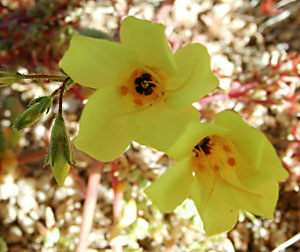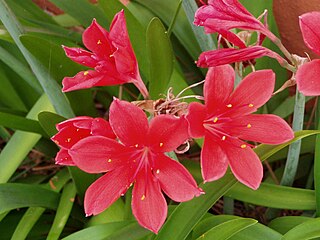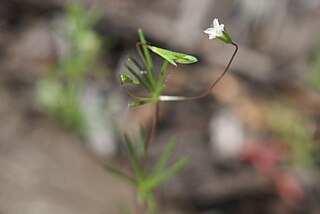
Coreopsis is a genus of flowering plants in the family Asteraceae. Common names include calliopsis and tickseed, a name shared with various other plants.

Linanthus is a genus of annual and perennial plants in the phlox family Polemoniaceae. The species are found in western North America and in Chile, with the greatest diversity in California.

Leptosiphon is a genus of flowering plants in the Polemoniaceae family. Many included species were formerly classified as members of the genus Linanthus. Some species of this genus are grown as ornamental plants.

Viola pedata, the birdsfoot violet, bird's-foot violet, or mountain pansy, is a violet native to sandy areas in central and eastern North America.

Cyrtanthus is a genus of perennial, herbaceous and bulbous plants in the family Amaryllidaceae, subfamily Amaryllidoideae.

Leptosiphon acicularis is a species of flowering plant in the phlox family known by the common names bristly linanthus and bristly leptosiphon.

Leptosiphon androsaceus is a species of flowering plant in the phlox family known by the common name of false babystars.

Leptosiphon aureus is a species of flowering plant in the phlox family known by the common name golden linanthus.
Leptosiphon bolanderi is a species of flowering plant in the phlox family known by the common name Bolander's linanthus.

Leptosiphon ciliatus is a species of flowering plant in the phlox family known by the common name whiskerbrush.

Leptosiphon grandiflorus is a species of flowering plant in the phlox family known by the common names large-flower linanthus and large flowered leptosiphon.

Leptosiphon harknessii is a species of flowering plant in the phlox family known by the common name Harkness' flaxflower.

Leptosiphon montanus is a species of flowering plant in the phlox family known by the common name mustang clover.

Leptosiphon nuttallii is a species of flowering plant in the phlox family known by the common name Nuttall's linanthus.

Leptosiphon pachyphyllus is a species of flowering plant in the phlox family, known by the common name Sierra linanthus.

Leptosiphon parviflorus is a species of flowering plant in the phlox family known by the common name variable linanthus.
Leptosiphon serrulatus is a rare species of flowering plant in the phlox family known by the common name Madera linanthus. It is endemic to California, where it is known from the chaparral and woodlands in the Sierra Nevada foothills, from Madera to Kern Counties.

Adela trigrapha is a moth of the family Adelidae or fairy longhorn moths. It was described by Zeller in 1876 and is found in western North America, from Vancouver Island to California.

Carex bicolor, the bicoloured sedge, is a species of sedge native to North America, Northern Europe and Northern Asia. The International Union for Conservation of Nature has assessed the plant's conservation status as being of least concern because it has a widespread distribution and faces no particular threats.

Juncus triglumis, called the three-flowered rush, is a species of flowering plant in the genus Juncus, native to the subarctic and subalpine Northern Hemisphere. It is typically found in calcareous tundra habitats and arcto-alpine fens. It is often found in association with Carex atrofusca and Carex bicolor in the so-called Caricion bicolori-atrofuscae alliance.
This page is based on this
Wikipedia article Text is available under the
CC BY-SA 4.0 license; additional terms may apply.
Images, videos and audio are available under their respective licenses.

















